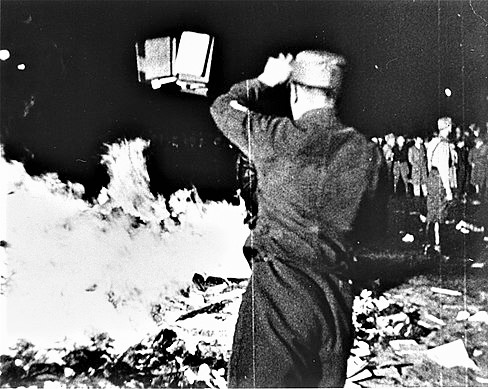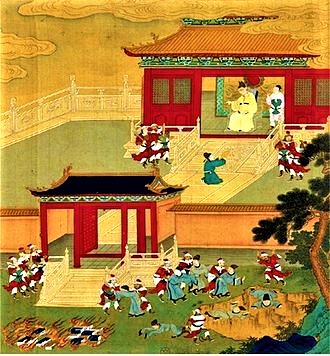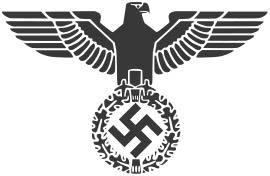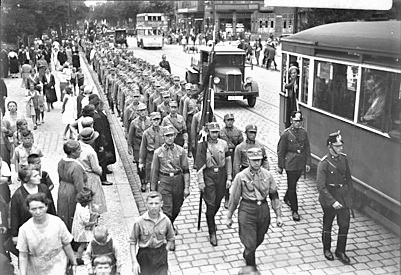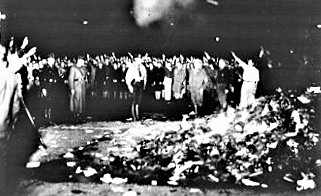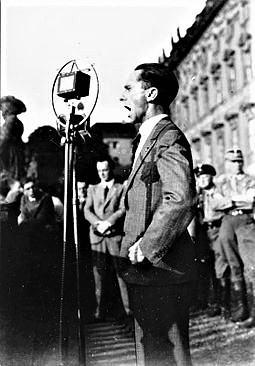The Destruction of Literary Heritage as a Tool in Cultural Genocide (Part 2)
TRANSCEND MEMBERS, 24 Jan 2022
Prof Hoosen Vawda – TRANSCEND Media Service
The Intentional Burning of “Un-German Literature” by Nazi Germany
The Part 1 of this series described the arsonistic burning of the Great Library at Alexandria, by reputedly no lesser a personage than that of Julius Caesar in 48 BC[i], during a civil war in Egypt, in which the Romans were involved. This fire destroyed irreplaceable volumes of books and valuable scrolls, built up by the Ptolemaic rulers of Egypt, with great diligence, expense in gold and prudence, making Alexandria a unique centre of academic excellence, research and learning, in antiquity.
There are also numerous examples of not only destruction of books throughput the ancient worlds but also execution of the authors and publishers, by the oppressive regimes, and placing their decapitated heads on spikes outside their homes, bookstores or library. In feudal China, the burning of books and live interment of scholars was widely practiced during the Qin Dynasty (213–210 BCE)[ii]. Han Confucians portrayed the legalistic Qin dynasty as a monolithic tyranny, notably citing a purge known as the burning of books and burying of scholars. also known as burning the books and executing the ru scholars,[iii] refers to the purported burning of texts in 213 BCE and live burial of 460 Confucian scholars in 212 BCE by the Chinese emperor Qin Shi Huang of the Qin dynasty. This was alleged to have destroyed philosophical treatises of the Hundred Schools of Thought, with the goal of strengthening the official Qin governing philosophy of Legalism. The Han dynasty historian, Sima Qian wrote that First Emperor, in an attempt to consolidate power, in 213 BC ordered the burning of all books advocating viewpoints that challenged Legalism or the state, and also stipulated that all scholars who refused to submit their books to be burned would be executed by premature burial.[iv] Only texts considered productive were to be preserved, mostly those that discussed pragmatic subjects, such as agriculture, divination, and medicine.[v] However, Sinologists now argue that the “burying of scholars” is not literally true, as the term probably meant simply “put to death”.[vi]
The House of Wisdom, called in Arabic as Bayt al-Ḥikmah, also known as the Grand Library of Baghdad, was a major Abbasid public academy and intellectual center in Baghdad, established by the Abbasid Caliphs during the Islamic Golden Age.[vii] This library was an example of wonton, cultural genocide, resulting in the total destruction of the Library of Baghdad by the Mongols during Hulagu Khan’s siege of city on 13th February, 1258, when the Mongols entered the city of the caliphs, starting a full week of pillage and destruction.[viii] During this barbaric period, along with all other libraries in Baghdad, the House of Wisdom was destroyed by the brutal army of Hulagu during the Siege of Baghdad.[ix] The books from Baghdad’s libraries were thrown into the Tigris River in such enormous numbers, that the river ran black with the ink from the books.[x] Nasir al-Din al-Tusi rescued about 400,000 manuscripts which he took to Maragheh before the siege.[xi] Many of the books were also torn apart by pillagers so that the leather covers could be made into sandals.[xii]
Additionally, in the 1430s Aztec leader Itzcoatl ordered the destruction of pictographic codices depicting the early history of the Aztecs, allowing for the development of a state-sanctioned history and mythos that venerated the deity Huitzilopochtli.[xiii] Also in Latin American ancient history, after hearing of the Roman Catholic Maya, who continued to practice idol worship, Fray Diego de Landa ordered an Inquisition in Mani, Yucatán, ending with a ceremony called A uto de Fé. During this ceremony on July 12, 1562, a disputed number of Maya codices, according to Landa, 27 books, and approximately 5000 Maya cult images were burned. This burning of Maya codices on the order of Bishop Diego de Landa in 1562 had achieved cultural genocide, using religion as a mitigating factor and “converting the heathens”.
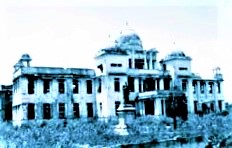
The burnt shell of the Jaffna Pubic library following the government orchestrated arson attacks on 01st June 1981
A recent episode is the burning of the Jaffna Public Library. This repository is located in Jaffna, Sri Lanka. It is one of Jaffna’s most notable landmarks, and is run by the Jaffna Municipal Council. The library was built in 1933 and burnt in 1981. During the early 1980s, it was one of the biggest libraries in Asia, containing over 97,000 books and manuscripts.[xiv] On the night of 01st June 1981, according to many eyewitnesses, police and government-sponsored para militias set fire to the Jaffna public library and destroyed it completely. Over a million books burnt in the 1981 arson attack. Some ancient Sinhala and Tamil books were never recovered resulting in total loss of cultural, literary heritage of ancient Ceylon, the Kingdom of King Ravana[xv], as depicted in the Hindu scripture, Ramayana.[xvi] This was clearly a literary genocide. Nancy Murray wrote in a journal article in 1984 that several high-ranking security officers and two cabinet ministers were present in the town of Jaffna, when uniformed security men and plainclothes[xvii] mob carried out organized acts of destruction.[xviii] After 20 years the government-owned Daily News newspaper, in an editorial in 2001, termed the 1981 event an act by “goon squads let loose by the then government”[xix] Of all the destruction in Jaffna city, it was the destruction of the Jaffna Public Library that was the incident which appeared to cause the most distress to the people of Jaffna.[xx] Twenty years later, the mayor of Jaffna Nadarajah Raviraj still grieved at the recollection of the flames he saw as a University student.[xxi] The burnt library, for the Tamilians, in Sri Lanka, became a symbol of “physical and imaginative violence”. The attack was seen as an assault on their aspirations, the value of learning and traditions of academic achievement. The attack also became the rallying point for Tamil rebel group called the Liberation Tigers of Tamil Eelam (LTTE), “Tamil Tigers”[xxii] , to promote the idea to the Tamil populace that their race was targeted for annihilation.[xxiii] This led to years of civil war based on ethnic differences between Sinhalese and Tamil citizens[xxiv], with the involvement of India, leading to unimaginable atrocities on both sides.[xxv]
In Europe, after the defeat of Germany in World War 1, the moral of the citizens was at its lowest point and the populace was easily influenced by groups purporting nationalistic fervor, to regains the self-esteem of the country. This led to the emergence and increasing popularity of radical groups I Germany. One such body were the Nazis. This group were of the opinion that the all the socio-economic maladies of post-World War 1 Germany were caused by the large Jewish population, who were also envied for their affluence and success as business entrepreneurs. The social conditions at the time were rife for the emergence of radicalized youth and drew large numbers of youth into the Nazi Party, towards the end of the decade of 1920s’ The ethnic tensions were festering between “the haves and have nots” in Germany. The Nazi Party, officially the National Socialist German Workers’ Party, was a far-right political party in Germany active between 1920 and 1945, which created and supported the ideology of Nazism. Its precursor, the German Workers’ Party existed from 1919 to 1920. The Nazi Party emerged from the German nationalist, racist and populist Freikorps paramilitary culture, which fought against the communist uprisings in post-World War I Germany. The party was created to draw workers away from communism and into “völkisch” nationalism.[xxvi] Initially, Nazi political strategy focused on anti-big business, anti-bourgeois, and anti-capitalist rhetoric. This was later downplayed to gain the support of business leaders, and in the 1930s the party’s main focus shifted to antisemitic and anti-Marxist themes.[xxvii]
Pseudoscientific racist theories were central to Nazism, expressed in the idea of a “people’s community” (Volksgemeinschaft).[xxviii] The party aimed to unite “racially desirable” Germans as national comrades, while excluding those deemed either to be political dissidents, physically or intellectually inferior, or of a foreign race (Fremdvölkische).[xxix] The Nazis sought to strengthen the Germanic people, the “Aryan master race”, through racial purity and eugenics, broad social welfare programs, and a collective subordination of individual rights, which could be sacrificed for the good of the state on behalf of the people. To protect the supposed purity and strength of the Aryan race, the Nazis sought to exterminate Jews, Romani, Poles and most other Slavs, along with the physically and mentally disabled. They disenfranchised and segregated homosexuals, people of African origins, Jehovah’s Witnesses, and political opponents.[xxx] The persecution reached its climax when the party-controlled German state set in motion the “Final Solution”. This was an industrial system of genocide which achieved the murder of around 6 million Jews and millions of other targeted victims, in what has become known as “The Holocaust”.[xxxi]
The infamous, Adolf Hitler, the leader of the Nazi Party since 1921, was appointed Chancellor of Germany by President Paul von Hindenburg on 30 January 1933. Hitler rapidly established a totalitarian regime known as the Third Reich.[xxxii]
This set an environment conducive to cultural and ethnic genocide. The first sign of the eruption of this deep discontent, manifested on 08th April 1933, when the Main Office for Press and Propaganda of the German Student Union (DSt) proclaimed a nationwide “Action against the Un-German Spirit”, which was to climax in a literary purge or “cleansing” (“Säuberung”) by fire. According to historian Karl Dietrich Bracher: The exclusion of “Left”, democratic, and Jewish literature took precedence over everything else. The black-lists ranged from Bebel, Bernstein, Preuss, and Rathenau through Einstein, Freud, Brecht, Brod, Döblin, Kaiser, the Mann brothers, Zweig, Plievier, Ossietzky, Remarque, Schnitzler, and Tucholsky, to Barlach, Bergengruen, Broch, Hoffmannsthal, Kästner, Kasack, Kesten, Kraus, Lasker-Schüler, Unruh, Werfel, Zuckmayer, and Hesse. The catalogue went back far enough to include literature from Helen Keller, Heine and Marx to Kafka.[xxxiii] Helen Keller published an “Open Letter to German Students”, in which she wrote: “You may burn my books and the books of the best minds in Europe, but the ideas those books contain have passed through millions of channels and will go on.”[xxxiv]
Local, Nazi Party chapters were to supply the press with releases and commissioned articles, sponsor well-known Nazi figures to speak at public gatherings, and negotiate for radio broadcast time. The DSt had contacted an official from the Propaganda Ministry to request support for their campaign, including having Propaganda Minister Josef Goebbels be the main speaker at the event in Berlin.[xxxv]
On the same day the Student Union published the “Twelve Theses”, a title chosen to be evocative of two events in German history: Martin Luther’s burning of a papal bull when he posted his ninety-five theses in 1520, and the burning of a handful of items, including 11 books, at the 1817 Wartburg Festival on the 300th anniversary of Luther’s burning of the bull. This was, however, a false comparison, as the “book burnings” at those historic events were not acts of censorship, nor destructive of other people’s property, but purely symbolic protests, destroying only one individual document of each title, for a grand total of 12 individual documents, without any attempt to suppress their content, whereas the Student Union burned tens of thousands of volumes, all they could find from a list comprising around 4000 titles.[xxxvi] The “Twelve Theses” called for a “pure” national language and culture. Placards publicized the theses, which attacked “Jewish intellectualism”, asserted the need to “purify” German language and literature, and demanded that universities be centres of German nationalism. The students described the action as a “response to a worldwide Jewish smear campaign against Germany and an affirmation of traditional German values.”[xxxvii]
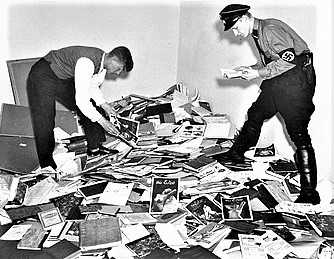
A German student and Nazi SA member plunder the library of Dr. Magnus Hirschfeld, Director of the Institute for Sexual Research in Berlin.
This picture was reportedly taken on the newly developed 35mm Leitz camera, smuggled to New York by the Jewish migrants and sold there for US$800, circa 1939[xxxviii]
(Note the pornographic pictures on the floor)
The first large burning came on 06th May 1933. The German Student Union made an organised attack on Dr. Magnus Hirschfeld’s Institut für Sexualwissenschaft (Institute of Sex Research). Its library and archives of around 20,000 books and journals were publicly hauled out and burned in the street. Its collection included unique works on intersexuality, homosexuality, and transgender topics. Dora Richter, the first transgender woman known to have undergone sex reassignment surgery by doctors at the Institute, is assumed to have been killed during the attack.[xxxix]
On 10th May 1933, the students burned upwards of 25,000 volumes of “un-German” books in the square at the State Opera, Berlin, thereby presaging an era of uncompromising state censorship. In many other university towns, nationalist students marched in torch lit parades against the “un-German” spirit. The scripted rituals of this night called for high Nazi officials, professors, rectors, and student leaders to address the participants and spectators. At the meeting places, students threw the pillaged, banned books into the bonfires with a great joyous ceremony that included live music, singing, “fire oaths,” and incantations. In Berlin, some 40,000 people heard Joseph Goebbels deliver a fiery address: “No to decadence and moral corruption!” Goebbels enjoined the crowd. “Yes to decency and morality in family and state! I consign to the flames the writings of Heinrich Mann, Ernst Glaeser,[xl] Erich Kästner.”
“The era of extreme Jewish intellectualism is now at an end. The breakthrough of the German revolution has again cleared the way on the German path…The future German man will not just be a man of books, but a man of character. It is to this end that we want to educate you. As a young person, to already have the courage to face the pitiless glare, to overcome the fear of death, and to regain respect for death – this is the task of this young generation. And thus you do well in this midnight hour to commit to the flames the evil spirit of the past. This is a strong, great and symbolic deed – a deed which should document the following for the world to know – Here the intellectual foundation of the November Republic is sinking to the ground, but from this wreckage the phoenix of a new spirit will triumphantly rise.” Joseph Goebbels, The Minister of Propaganda, speech to the students in Berlin.[xli] In his speech, which was broadcast on the radio, Goebbels’ referred to the authors whose books were being burned as “Intellectual filth” and “Jewish asphalt literati”.[xlii]
Not all book burnings took place on 10th May as the German Student Union had planned. Some were postponed a few days because of inclement weather. Others, based on local chapter preference, took place on 21st June, the summer solstice, a traditional date of celebration. Nonetheless, in 34 university towns across Germany the “Action against the Un-German Spirit” was a success, enlisting widespread newspaper coverage. In Berlin, radio broadcasts brought the speeches, songs, and ceremonial incantations “live” to countless German listeners.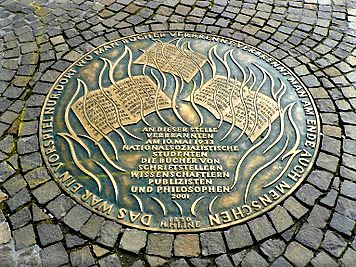
Memorial for book burning in 1933; on the ground of Römerberg Square in front of Frankfurt City Hall, Hesse, Germany
The following types of literature, as described by the Nazis, were made illegal and were blacklisted to be burnt. The authors, were incarcerated and some of them died in concentration camps, or simply disappeared. These actions of the Nazi Party in Germany were incorporated into the legislature of South Africa[xliv], under the nationalist apartheid government, in 1948. Liberation activists were imprisoned in Robben Island off the coast of Cape Town, for the possession of “subversive literature” during the era of racial discrimination and severe oppression of the “non-Whites” in South Africa.[xlv]:
While the list of un-German literature was comprehensive, often individuals decided what was considered as ‘undesirable literature” or ideology.
- The works of traitors, emigrants and authors from foreign countries who believe they can attack and denigrate the new Germany, such as H. G. Wells and Romain Rolland.
- The literature of Marxism, Communism and Bolshevism;
- Pacifist literature;
- Literature with liberal, democratic tendencies, attitudes, and writings supporting the Weimar Republic (Walther Rathenau, Heinrich Mann, Thomas Mann[xlvi]
- All historical writings whose purpose is to denigrate the origin, the spirit and the culture of the German Volk, or to dissolve the racial and structural order of the Volk, or that denies the force and importance of leading historical figures in favor of egalitarianism and the masses, and which seeks to drag them through the mud such as Emil Ludwig.
- Books that advocate “art” which is decadent, bloodless, or purely constructivist, like works of George Grosz, Otto Dix, Bauhaus, Felix Mendelssohn.
- Writings on sexuality and sexual education which serve the egocentric pleasure of the individual and thus, completely destroy the principles of race and Volk (Magnus Hirschfeld;
- The decadent, destructive and Volk-damaging writings of “Asphalt and Civilization” literati such as Oskar Maria Graf, Heinrich Mann, Stefan Zweig, Jakob Wassermann, Franz Blei.
- Literature by any Jewish authors, regardless of the field.
- Popular entertainment literature that depicts life and life’s goals in a superficial, unrealistic and sickly-sweet manner, based on a bourgeois or upper-class view of life;
- Patriotic kitsch in literature.
- Pornography and explicit literature
- All books degrading German purity or critical of Adolph Hitler and the Nazi Party, no matter what they engaged in, was incorrect by societal and international norms.
Some exiled authors despaired and committed suicide, for example: Walter Hasenclever, Ernst Weiss, Carl Einstein, Walter Benjamin, Ernst Toller, and Stefan Zweig.[xlvii] Many German students were complicit in the Nazi book burning campaign. They were known as Deutsche Studentenschaft, and when they ran out of books in their own libraries they turned to independent bookstores. Libraries were also asked to stock their shelves with material that stood up to Hitler’s standards, and destroy anything that did not.[xlviii]
Apart from cultural genocide being practiced in Germany itself, it was widely used in occupied territories, as well. Among the Nazi crimes against the Polish nation was a campaign of cultural genocide that included the burning of millions of books, resulting in the destruction of an estimated 80% of all school libraries, and three-quarters of all scientific libraries in occupied Poland.[xlix] The Nazis also seized many books from Jewish communities in Eastern Europe. They did intend to keep and display a few rare and ancient books in a museum on Judaism after the “Final Solution”[l] was successfully completed.[li]
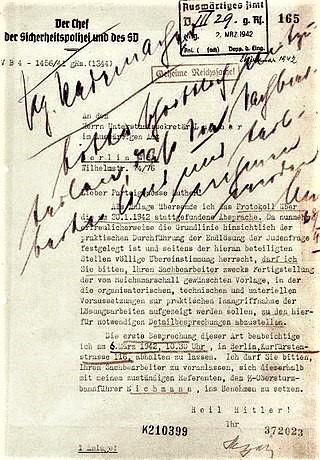
Follow-up letter from Reinhard Heydrich to the German diplomat Martin Luther asking for administrative assistance in the implementation of the Final Solution, 26th February 1942
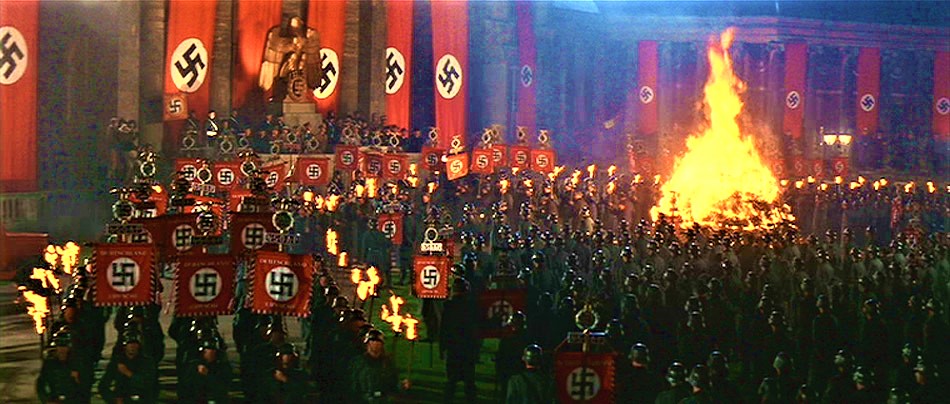
Reconstructed Scene of the 1938 Burning of un-German Books in a massive rally attended by Hitler in Berlin From Steven Spielberg’s Indiana Jones and the Last Crusade 1989
The Bottom Line is that the Book Burning Campaign was a prelude to the Holocaust in which over six million people of Jewish Origins, the powers that were at the time failed to recognise this and subsequently allowed the murder of Jews, purely based on the fact that Hitler and his Nazi Party thought of themselves as having originated from the superior Aryan Stock and everybody else was inferior. The picture above, taken the 1989 film “Indiana Jones and the Last Crusade” features a scene set against the backdrop of a book burning event, which is part of a large Nazi rally in Berlin attended by Adolf Hitler.[lii] While the fictional scene was set in 1938 and held at the Institute of Aryan Culture, this actually happened and even today, 83 years later, cultural genocide is still in progress which will eventually climax in human genocide.
On 13th December 1797: Heinrich Heine is born. This German poet once observed that wherever books are burned, people are burned, too, in the end. His words turned out to be prophetic, as his own books would be burnt by the Nazis during the 1930s. Heinrich Heine was a Jewish born poet who became a highly controversial figure in German literature and was also something of a visionary. He quite clearly prophesied the terrible times to come for the Jewish people in a play that he wrote in 1821. In “Almansor” he wrote about the burning of books for political or religious reasons and the line: “Das war ein Vorspiel nur, dort wo man Bucher verbrennt man auch am Ende Menschen” translates as “That was but a prelude; where they burn books, they will ultimately burn people also”. Ironically, over a hundred years later Nazi party activists raided the Institut für Sexualwissenschaft and burned thousands of books on Berlin’s Opernplatz, including some of the works of Heinrich Heine.[liii]
References:
[1] https://www.bing.com/search?q=which+year+did+julius+Caesar+burnt+the+Library+at+Alexandria&cvid=2da8aabcd3474a48a22fd476aa392d0c&aqs=edge..69i57.24258j0j1&pglt=43&FORM=ANNTA1&PC=U531#:~:text=Date-,48%20BC,-According%20to%203
[2] https://en.wikipedia.org/wiki/Qin_dynasty#:~:text=The%20Qin%20dynasty%2C%20also%20spelt%20Kin%20or%20Ch%27in,Qin%20Shi%20Huang%2C%20the%20First%20Emperor%20of%20Qin.
[3] Xinzhong Yao (11 May 2015). The Encyclopedia of Confucianism: 2-volume set. Routledge. pp. 317–. ISBN 978-1-317-79348-9.
[4] https://en.wikipedia.org/wiki/Burning_of_books_and_burying_of_scholars
[5] https://en.wikipedia.org/wiki/Qin_dynasty#:~:text=%5E-,Borthwick%2C%20p.%2011,-%5E%20Bodde%20(1986)%2C%20p
[6] https://en.wikipedia.org/wiki/Qin_dynasty#CITEREFBodde1986
[7] https://books.google.com/books?id=6cm_KK6Ubk8C&pg=PA53
[8] https://books.google.com/books?id=aJ5zDM1KfewC&pg=PT53
[9] https://findatwiki.com/Library_of_Baghdad#:~:text=Al%2DKhalili%202011%2C%20p.%20233
[10] https://web.archive.org/web/20160814182125/http://lostislamichistory.com/mongols/#
[11] https://findatwiki.com/Library_of_Baghdad#:~:text=manuscripts%20which%20he%20took%20to%20Maragheh%20before%20the%20siege
[12] https://findatwiki.com/Library_of_Baghdad#:~:text=Many%20of%20the%20books%20were%20also%20torn%20apart%20by%20pillagers%20so%20that%20the%20leather%20covers%20could%20be%20made%20into%20sandals.
[13] https://www.bing.com/search?q=the+destruction+of+Aztec+codices+by+Itzcoatl+(1430s)&aqs=edge..69i57.4957544j0j1&pglt=43&FORM=ANNTA1&PC=U531#:~:text=Date-,In%20the%201430s%20Aztec%20leader%20Itzcoatl%20ordered%20the%20destruction%20of%20pictographic%20codices%20depicting%20the%20early%20history%20of%20the%20Aztecs%2C%20allowing%20for%20the%20development%20of%20a%20state%2Dsanctioned%20history%20and%20mythos%20that%20venerated%20the%20deity%20Huitzilopochtli.,-Fear%20of%20Knowledge
[14] https://web.archive.org/web/20140319091509/http://english.jaffnalibrary.lk/library.php
[15] https://en.wikipedia.org/wiki/Ravana
[16] https://www.learnreligions.com/the-ramayana-summary-by-stephen-knapp-4092441#:~:text=The%20Ramayana%20is%20the%20epic%20tale%20of%20Shri,to%20as%20the%20Adi%20Kavya%20or%20original%20epic.
[17] https://web.archive.org/web/20051224070539/http://www.priu.gov.lk/news_update/features/20020130jaffna_library.htm
[18] https://en.wikipedia.org/wiki/Burning_of_Jaffna_Public_Library#:~:text=Nancy%20Murray%20(1984)%2C%20Sri%20Lanka%3A%20Racism%20and%20the%20Authoritarian%20State%2C%20Issue%20no.%201%2C%20Race%20%26%20Class%2C%20vol.%2026%20(Summer%201984)
[19] https://web.archive.org/web/20040921183752/http://www.priu.gov.lk/news_update/EditorialReviews/erev200106/20010608editorialreview.html
[20] Peebles, Patrick (2006) [2006]. “chapter 10”. The History of Sri Lanka. The Greenwood Histories of the Modern Nations. Westport, Connecticut: Greenwood Press. pp. 133 & 134. ISBN 0-313-33205-3.
[21] https://en.wikipedia.org/wiki/Sengai_Aaliyan
[22] https://simple.wikipedia.org/wiki/Liberation_Tigers_of_Tamil_Eelam#:~:text=From%20Simple%20English%20Wikipedia%2C%20the%20free%20encyclopedia%20The,LTTE%20are%20also%20known%20as%20the%20Tamil%20Tigers.
[23] “The reconstruction of the Jaffna library by Dr. Jayantha Seneviratne”. PRIU. Archived from the original on December 24, 2005.
[24] https://janetpanic.com/what-was-the-reason-for-civil-war-in-sri-lanka/#:~:text=What%20was%20the%20reason%20for%20civil%20war%20in,What%20happened%20in%20the%20Sri%20Lankan%20civil%20war%3F
[25] https://www.thoughtco.com/the-sri-lankan-civil-war-195086#:~:text=In%20the%20late%2020th%20century%2C%20the%20island%20nation,large%20part%20because%20of%20Sri%20Lanka%27s%20colonial%20history.
[26] https://en.wikipedia.org/wiki/Nazi_Party#CITEREFMitchell2008
[27] https://en.wikipedia.org/wiki/Nazi_Party#CITEREFMcDonough2003
[28] https://en.wikipedia.org/wiki/Nazi_Party#CITEREFMajer2013
[29] https://en.wikipedia.org/wiki/Nazi_Party#CITEREFWildt2012
[30] https://en.wikipedia.org/wiki/Nazi_Party#CITEREFGigliottiLang2005
[31] https://en.wikipedia.org/wiki/Nazi_Party#CITEREFEvans2008
[32] https://en.wikipedia.org/wiki/Nazi_Party#CITEREFElzer2003
[33] Bracher, Karl Dietrich (1970). The German Dictatorship. Translated by Jean Steinberg. New York: Penguin Books. p. 325. ISBN 0-14-013724-6.
[34] https://en.wikipedia.org/wiki/Nazi_book_burnings#:~:text=%5E-,Baez%202011%2C%20p.%20211,-%5E
[35] https://en.wikipedia.org/wiki/Nazi_book_burnings#:~:text=Local%20chapters%20were,event%20in%20Berlin.
[36] http://ualibr-exhibits.s3-website-us-west-2.amazonaws.com/burnedbooks/
[37] https://en.wikipedia.org/wiki/Nazi_book_burnings#:~:text=The%20%22Twelve%20Theses%22%20called,of%20traditional%20German%20values.%E2%80%9D
[38] https://en.wikipedia.org/wiki/Leica_Camera
[39] http://drvitelli.typepad.com/providentia/2010/12/dorchens-story.html
[40] Frei, Norbert (1993) National Socialist Rule in Germany: The Führer State 1933-1945. Translated by Simon B. Steyne. Oxford, Blackwell Publishers. p.62 ISBN 0-631-18507-0
[41] Dickerman, Michael; Bartrop, P.R. (2017). The Holocaust: An Encyclopedia and Document Collection [4 Volumes]. ABC-CLIO. p. 458. ISBN 9781440840845.
[42] Reuth, Ralf Georg (1993). Goebbels. A Harvest Book. Translated by Winston, Krishna. Harcourt Brace. pp. 182–183. ISBN 9780156001397.
[43] https://www.britannica.com/event/Lausanne-Conference-1932
[44] https://www.bing.com/search?q=apartheid+laws+in+south+africa&cvid=19e789e8f19c4c3db93858e14df0483c&aqs=edge.2.69i57j69i59l2j69i64.7865j0j1&pglt=43&FORM=ANNTA1&PC=U531#:~:text=See%20all-,The%20first%20apartheid%20law%20was%20the%20Prohibition%20of%20Mixed%20Marriages%20Act%2C%201949%2C%20followed%20closely%20by%20the%20Immorality%20Amendment%20Act%20of%201950%2C%20which%20made%20it%20illegal%20for%20most%20South%20African%20citizens%20to%20marry%20or%20pursue%20sexual%20relationships%20across%20racial%20lines,-.
[45] https://searchblackandeducation.com/stories/2017/2/5/selected-laws-from-apartheid
[46] Frei, Norbert (1993) National Socialist Rule in Germany: The Führer State 1933-1945. Translated by Simon B. Steyne. Oxford, Blackwell Publishers. p.62 ISBN 0-631-18507-0
[47] https://en.wikipedia.org/wiki/Nazi_book_burnings#:~:text=Exiled%20authors%20despaired%20and%20committed%20suicide%2C%20for%20example%3A%20Walter%20Hasenclever%2C%20Ernst%20Weiss%2C%20Carl%20Einstein%2C%20Walter%20Benjamin%2C%20Ernst%20Toller%2C%20and%20Stefan%20Zweig.
[48] Lyons, Martyn. Books: A Living History. Los Angeles: J. Paul Getty Museum, 2011. chapter 5 p.200-1
[49] Hench, John B. (2010) Books As Weapons, pg. 31. Ithaca, New York: Cornell University Press. ISBN 978-0-8014-4891-1
[50] https://en.wikipedia.org/wiki/Final_Solution
[51] https://en.wikipedia.org/wiki/Nazi_book_burnings#:~:text=Lyons%2C%20Martyn.%20Books%3A%20A%20Living%20History.%20Los%20Angeles%3A%20J.%20Paul%20Getty%20Museum%2C%202011.%20chapter%205%20p.200%2D1
[52] https://en.wikipedia.org/wiki/Nazi_book_burnings#:~:text=The%201989%20film%20Indiana%20Jones%20and%20the%20Last%20Crusade%20features%20a%20scene%20set%20to%20the%20backdrop%20of%20a%20book%20burning%20event%20which%20is%20part%20of%20a%20large%20Nazi%20rally%20in%20Berlin%20attended%20by%20Adolf%20Hitler.%20The%20fictional%20scene%20was%20set%20in%201938%20and%20held%20at%20the%20Institute%20of%20Aryan%20Culture.
[53] https://medium.com/la-mia-biblioteca/where-they-burn-books-they-will-ultimately-burn-people-also-34b835d13b7d#:~:text=December%2013%2C%201797,of%20Heinrich%20Heine.
______________________________________________
 Professor G. Hoosen M. Vawda (Bsc; MBChB; PhD.Wits) is a member of the TRANSCEND Network for Peace Development Environment.
Professor G. Hoosen M. Vawda (Bsc; MBChB; PhD.Wits) is a member of the TRANSCEND Network for Peace Development Environment.
Director: Glastonbury Medical Research Centre; Community Health and Indigent Programme Services; Body Donor Foundation SA.
Principal Investigator: Multinational Clinical Trials
Consultant: Medical and General Research Ethics; Internal Medicine and Clinical Psychiatry:UKZN, Nelson R. Mandela School of Medicine
Executive Member: Inter Religious Council KZN SA
Public Liaison: Medical Misadventures
Activism: Justice for All
Email: vawda@ukzn.ac.za
Tags: Books, History, Literacy, Literature
This article originally appeared on Transcend Media Service (TMS) on 24 Jan 2022.
Anticopyright: Editorials and articles originated on TMS may be freely reprinted, disseminated, translated and used as background material, provided an acknowledgement and link to the source, TMS: The Destruction of Literary Heritage as a Tool in Cultural Genocide (Part 2), is included. Thank you.
If you enjoyed this article, please donate to TMS to join the growing list of TMS Supporters.

This work is licensed under a CC BY-NC 4.0 License.
